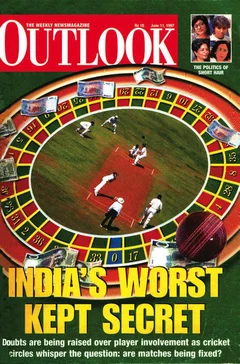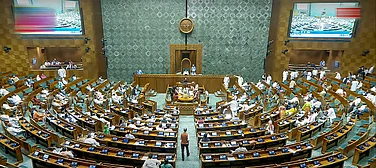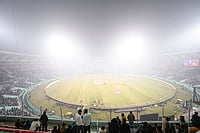THE massive Naxalite congregation in Calcutta last week to celebrate 30 years of the movement ended quite tamely—in 10 minutes flat—because of a massive thunderstorm. The renowned balladeer, Gaddar, who recently survived four bullets allegedly fired by the Andhra Pradesh police, was just beginning his act when the downpour dispersed the diverse, battle-weary gathering. The Bengal Naxal brigade was represented by veterans Suniti Ghosh and Nisith Bhattacharya, who resurfaced after ages. Other comrades swapped memories, looking out of place among a predominantly non-Bengali milieu-peasants and tribals from Andhra Pradesh, Bihar, Rajasthan and Madhya Pradesh who sang, danced, and shouted rousing pro-Naxalbari slogans. So limited was West Bengal's contribution that one onlooker commented: "The initial spark of the Naxalbari movement may have occurred here, but the embers blaze elsewhere. The Naxalbari movement was sparked off by the symbolic killing of police inspector Sonam Wang Di in Naxalbari in Darjeeling district during a raid in April 1967. In retaliation, the Assam Rifles had killed 11 people, including two children and seven women. The rest is history, as Bengal exploded in protest. But the Naxal movement is now almost dead in the place of its origin, though it is still an instrument of social change elsewhere—in central and south Bihar, and the Naxal-controlled 'Dandakaranya' area, comprising several districts of Andhra Pradesh, Orissa, Madhya Pradesh and Maharashtra. In these new battle-fronts, Naxal factions like the Maoist Communist Centre, Party Unity and the People's War Group are engaged in armed agitation against the establishment. So how has this change of locale come about? Says Dhruva Chatterjee, a lecturer who witnessed the pogrom at Baranagar, a Calcutta suburb, in the mid-'70s: "A major reason is that Bengal Naxalites had been put through the grind, as the full might of the state power was turned against them. Summary executions by the police or officially-sponsored anti-socials became commonplace. Even family members were not spared and over 300 people were feared killed at Baranagar in a week of reprisals against a single murder during then chief minister S.S. Ray's tenure." Human rights activists and the press looked the other way, for the Naxals had alienated almost everybody with their disastrous 'annihilation' programme, a brainchild of the late Charu Mazumdar who insisted an the liquidation of "class enemies"—the definition was wide enough to cover traffic policemen. Despite the counter-offensive by the state, the Naxalites made gains in rural West Bengal, in pockets like Naxalbari, Gopiballavpur, Debra and Birbhum, where they sided with the poorest of the poor peasants. 'Their programmes in urban areas, consisting of attacks on educational institutions and rival parties, alienated them further. Officially, 65 constables were killed and over 3,500 youths, sympathisers, family members died in police firings, encounters, political clashes. The main support came from unemployed youths or poor peasants who felt they had nothing to lose. But Azizul Haque, a leader who refused to compromise and underwent police torture and a long detention, puts the toll at 7,000—"they died at the hands of law enforcing agencies, and the CPI(M) and the Congress in the seventies." In fact, he refutes the view that the Naxal movement is dead: "There is no reason why we should celebrate 30 years of a movement which is very much alive. The Naxals are fighting a battle against the state in Andhra Pradesh; in Bihar, feudally exploited people are challenging the monopoly of rich landlords in the rural economy. In Bengal, most ex-Naxalites, including the brilliant students it had on its rolls, have returned to the "establishment"-some took up teaching, others joined the civil service, a few like Ashim Chatterjee made peace with the mainstream Left. Summing up the contribution of the movement, a civil servant said: "The romantic youths underestimated the power of the state. They forgot that in a large country, the deaths of even 3,000 people hardly made ripples.... What they did achieve was to make the government conscious that poverty could not be un-addressed for long. In fact, the government introduced development schemes in Bengal that were not on the agenda." The Naxal movement may be dead in Bengal, but it is still an instrument of social change in parts of Bihar, Andhra Pradash and Madhya Pradesh.
Embers Of A Revolt
Thirty years on, the Naxal movement is lost in its place of origin

The Memorial of Naxal Bari Movement at Bayngai Joyt at Naxal Bari area --on 10-04-17- Photo: By Sandipan Chatterjee
The Memorial of Naxal Bari Movement at Bayngai Joyt at Naxal Bari area --on 10-04-17- Photo: By Sandipan Chatterjee
Published At:
MOST POPULAR
WATCH
MORE FROM THE AUTHOR
PHOTOS
×



















